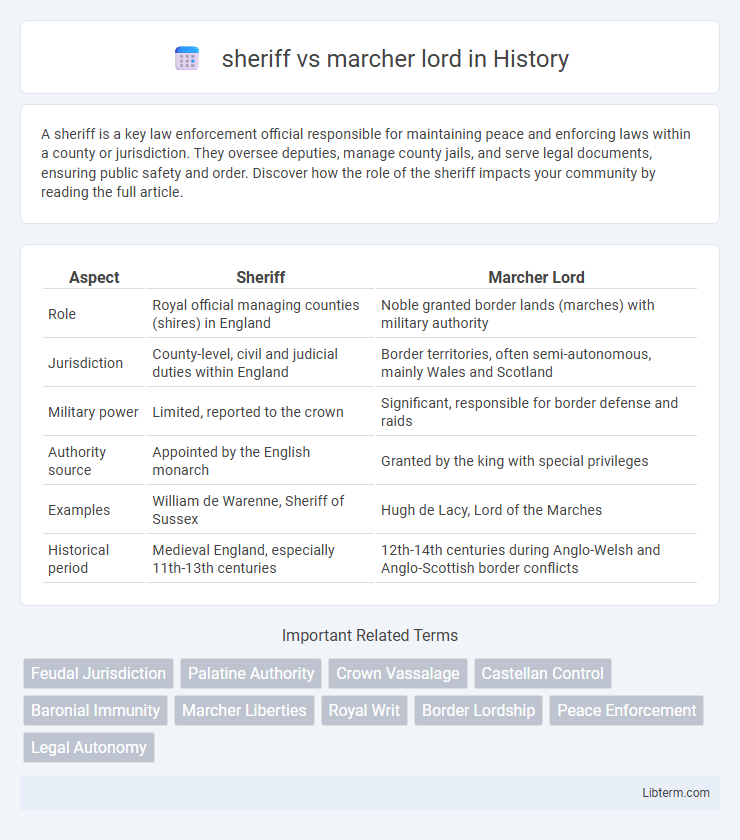A sheriff is a key law enforcement official responsible for maintaining peace and enforcing laws within a county or jurisdiction. They oversee deputies, manage county jails, and serve legal documents, ensuring public safety and order. Discover how the role of the sheriff impacts your community by reading the full article.
Table of Comparison
| Aspect | Sheriff | Marcher Lord |
|---|---|---|
| Role | Royal official managing counties (shires) in England | Noble granted border lands (marches) with military authority |
| Jurisdiction | County-level, civil and judicial duties within England | Border territories, often semi-autonomous, mainly Wales and Scotland |
| Military power | Limited, reported to the crown | Significant, responsible for border defense and raids |
| Authority source | Appointed by the English monarch | Granted by the king with special privileges |
| Examples | William de Warenne, Sheriff of Sussex | Hugh de Lacy, Lord of the Marches |
| Historical period | Medieval England, especially 11th-13th centuries | 12th-14th centuries during Anglo-Welsh and Anglo-Scottish border conflicts |
Introduction: Understanding Sheriffs and Marcher Lords
Sheriffs were royal officials responsible for administering justice and maintaining law and order within English counties during the medieval period. Marcher Lords held semi-autonomous authority along the volatile borders between England and Wales, tasked with defense and governance in these frontier regions. The distinct roles highlight the centralized judicial power of sheriffs versus the military and territorial control exercised by Marcher Lords.
Historical Origins of Sheriffs and Marcher Lords
Sheriffs originated in Anglo-Saxon England as royal officials responsible for maintaining law and order within shires, acting as the king's principal representatives in local governance. Marcher Lords emerged along the medieval Welsh borderlands, granted extensive autonomous powers to defend and expand the frontier, blending military and administrative roles. Both offices reflect adaptations to regional challenges, with sheriffs enforcing centralized royal authority and marcher lords exercising semi-independent control in volatile border zones.
Roles and Responsibilities: Sheriff vs Marcher Lord
Sheriffs managed local law enforcement, tax collection, and court administration within English counties, ensuring royal authority and legal order. Marcher Lords held military and administrative power in border regions between England and Wales, responsible for defense, local governance, and maintaining peace in turbulent frontier zones. While sheriffs operated under central royal authority, marcher lords enjoyed quasi-autonomous rule, often exercising greater military and judicial independence.
Authority and Jurisdiction Compared
A sheriff held royal authority within a shire, responsible for law enforcement, tax collection, and administration of justice under direct crown mandate. A marcher lord exercised semi-autonomous power in border regions, possessing military and judicial authority to govern volatile frontier territories with considerable independence from central monarchy. The sheriff's jurisdiction was limited and clearly defined by royal appointment, whereas marcher lords wielded broader, hereditary rights often combining civil governance and military command in their marcher lordships.
Military Functions and Feudal Power
Sheriffs exercised military functions by organizing local militias and maintaining law and order within shires, while marcher lords commanded heavily fortified border territories with autonomous military authority to defend against external invasions. Marcher lords held extensive feudal power, including rights to build castles, raise private armies, and administer justice independently of the crown. Sheriffs, appointed by the king, had more limited feudal power focused on tax collection and enforcing royal decrees, contrasting with the quasi-sovereign status of marcher lords on volatile frontiers.
Relationship to the Crown and Local Nobility
Sheriffs served as royal officials directly appointed by the Crown to enforce law, collect taxes, and manage royal estates, thereby representing centralized authority in local governance. Marcher Lords, granted semi-autonomous powers by the Crown, controlled border territories with extensive military and administrative rights, often operating with considerable independence from both the monarchy and local nobility. This distinction in the relationship to the Crown and local aristocracy shaped their respective roles, with sheriffs acting as Crown agents and marcher lords functioning as quasi-sovereign rulers in frontier regions.
Legal Powers: Law Enforcement and Administration
Sheriffs held significant legal powers in medieval England, including law enforcement, tax collection, and presiding over local courts within their shires. Marcher Lords, governing border territories between England and Wales, exercised special judicial authority, often operating semi-autonomously with the ability to create laws, maintain private armies, and enforce justice beyond the reach of the English crown's direct control. While sheriffs were royal appointees enforcing centralized legal codes, marcher lords combined military and legal authority to manage and defend volatile frontier regions.
Influence on Local Governance and Communities
Sheriffs held formal judicial and administrative authority, enforcing royal law and collecting taxes, directly shaping local governance through established legal frameworks. Marcher lords exercised semi-autonomous control in border regions, combining military power with administrative duties, often creating localized governance structures distinct from the crown's usual influence. Their presence fostered unique community dynamics, blending local customs with martial oversight to maintain order and security in contentious territories.
Decline and Evolution of Their Roles
The decline of sheriffs and marcher lords began as centralized royal authority expanded, reducing their regional autonomy and judicial powers. By the late medieval period, sheriffs transitioned from powerful local rulers to primarily administrative officers enforcing royal decrees, while marcher lords faced diminishing military significance due to the pacification of borderlands. Evolving legal frameworks and the rise of professional bureaucracies further eroded their traditional feudal privileges, shifting the balance toward centralized governance.
Legacy of Sheriffs and Marcher Lords in Modern History
Sheriffs, historically royal appointees managing local law enforcement and administration, laid the groundwork for modern judicial systems and civil governance in England. Marcher Lords, granted semi-autonomous powers along the Welsh border, influenced the development of regional military defense and feudal authority with lasting impacts on border governance. Their legacy endures in contemporary legal frameworks and regional administrative divisions, shaping the balance between centralized authority and local autonomy.
sheriff Infographic

 libterm.com
libterm.com